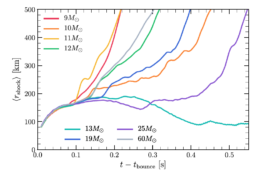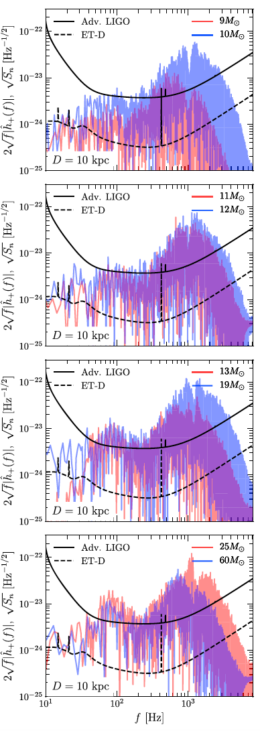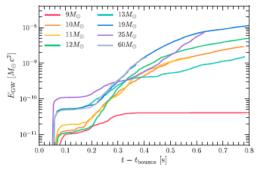When massive stars explode as supernovae, they fling shredded stellar material into the interstellar medium. The explosion should also generate gravitational waves, but astronomers haven’t detected any yet. Is it just a matter of time before we detect gravitational waves from core-collapse supernovae, or are the signals still out of reach?
Cosmic Fireworks

Expansion of the simulated supernova shock waves as a function of time since the outer layers of the star bounced off the core. All but the 13-solar-mass simulation exploded successfully. [Radice et al. 2019]
Gravitational-wave observations could be the key to understanding what goes on in the chaotic moments after massive stars collapse. To determine whether we can hope to detect these stellar explosions with our current gravitational-wave observatories — and what we could learn from the observations if we can detect them — a team led by David Radice (Princeton University) conducted three-dimensional simulations of eight supernovae.
When Stars Explode (Digitally)
Radice and coauthors began with models of supernova progenitor stars with masses between 9 and 60 times the mass of the Sun. For each simulated stellar collapse, the authors tracked the shock wave expansion, neutrino luminosity, and gravitational-wave emission as a function of time.
They found that gravitational waves were generated shortly after the collapse by convection in the material just outside the newly formed neutron star — a proto-neutron star — cooling at the supernova’s center. At later times (more than 0.2 seconds after the collapse), the gravitational-wave signal is dominated by oscillations of the proto-neutron star, which are driven by accreted material striking its surface.
The authors also show that the amount of energy radiated away in the form of gravitational waves is correlated with the amount of turbulent energy of the material accreting onto the proto-neutron star. This hints that gravitational-wave observations can provide an estimate of how turbulent the material behind the shock wave is.
These observations can also help us understand the nature of the proto-neutron star itself. The peak frequency of the signal is set by the proto-neutron star’s oscillation frequency, which depends on its interior structure. Clearly, gravitational waves can reveal a lot about what happens in a star’s final moments — but can we even detect them?
Catching a Wave
The authors found that the best possible signal-to-noise ratio for a supernova 33,000 light-years away ranges from 1.5 to 11.5, depending on the mass of the progenitor; for comparison, the signal-to-noise ratio for LIGO’s first detected black-hole merger was 24. While the authors acknowledge that this doesn’t mean that gravitational waves from core-collapse supernovae are undetectable with current observatories, the odds of detecting one are greater with future, more sensitive observatories.
In the case of the Einstein Telescope, a proposed gravitational-wave detector with a planned completion date of 2030, the calculated signal-to-noise ratio ranges from 20 to 110. Hopefully, the advent of third-generation detectors in the next couple of decades will bring an explosion of gravitational-wave data, allowing astronomers to peer into the turbulent interiors of collapsing stars.Citation
“Characterizing the Gravitational Wave Signal from Core-collapse Supernovae,” David Radice et al. 2019 ApJL 876 L9. doi:10.3847/2041-8213/ab191a


